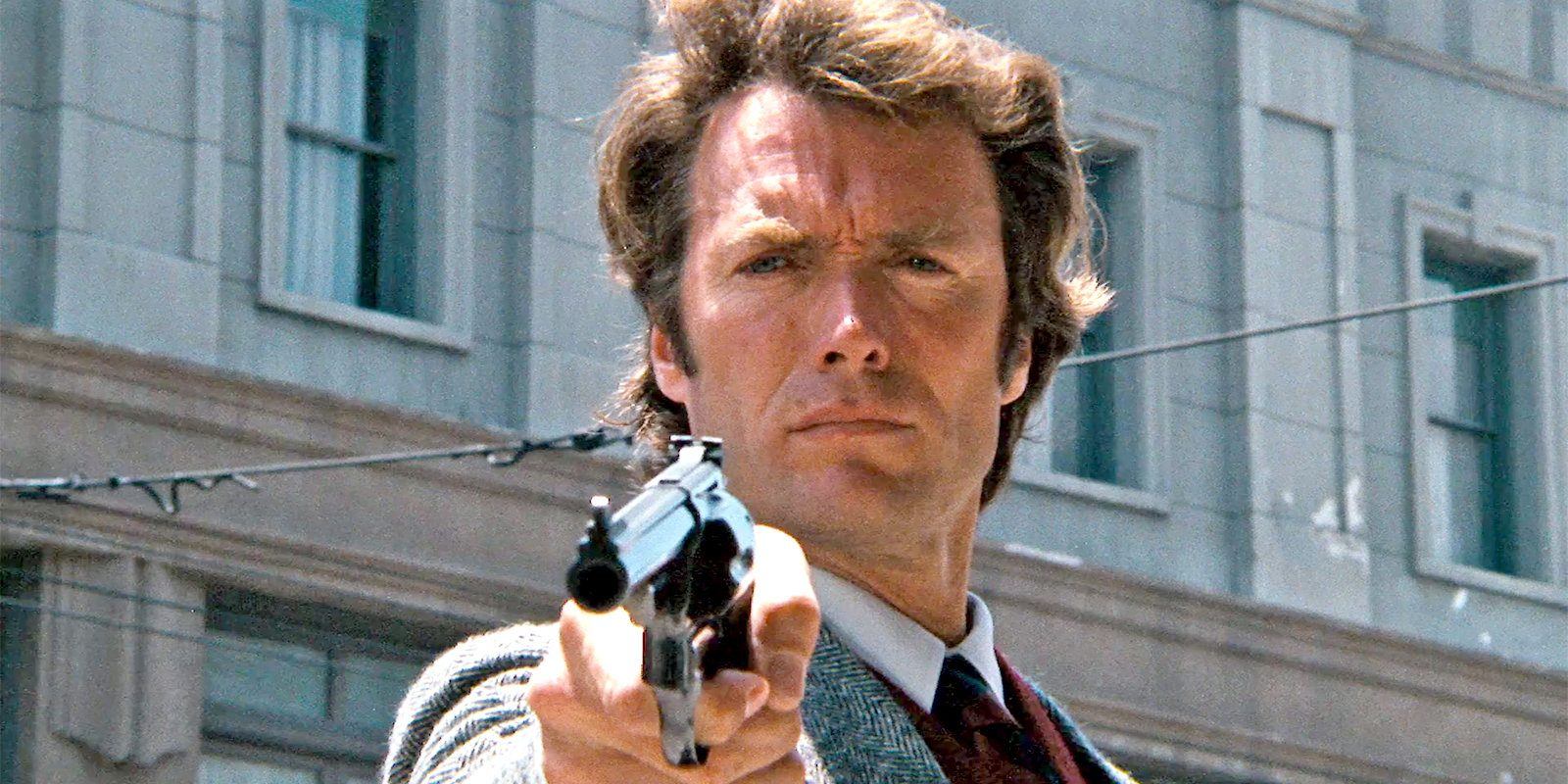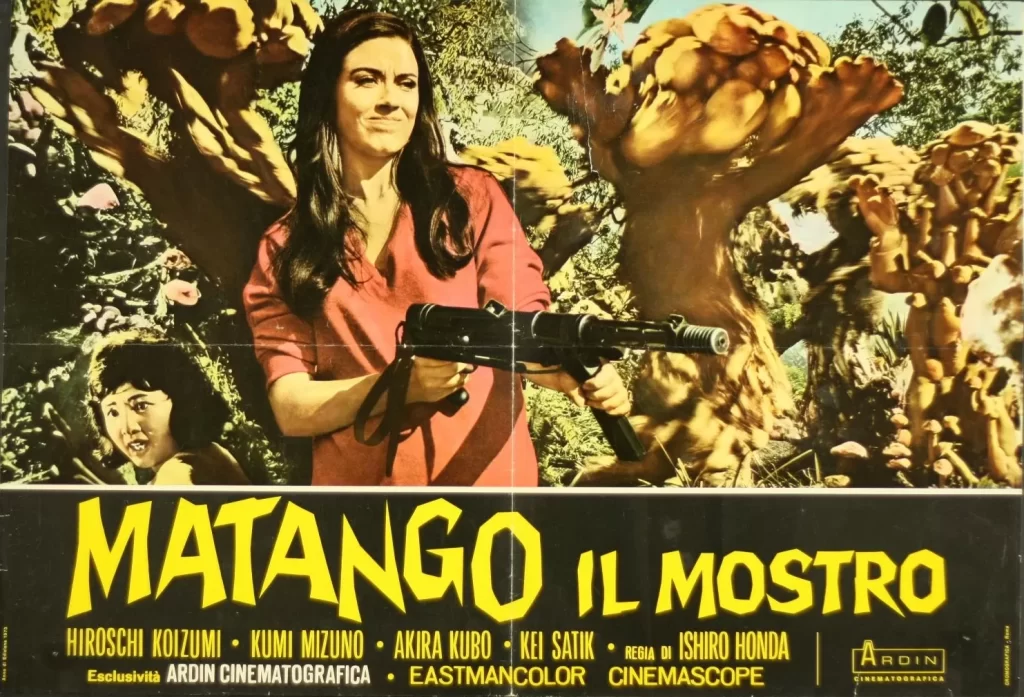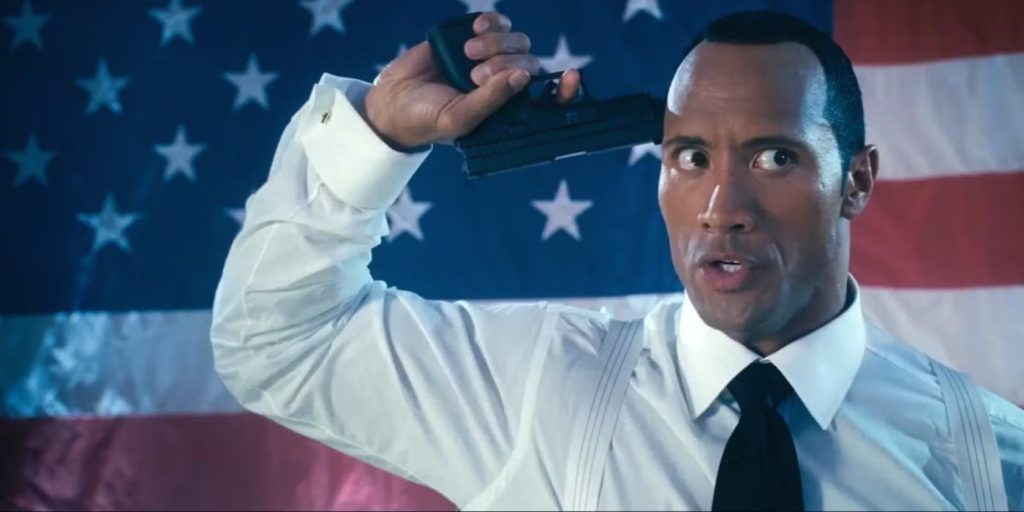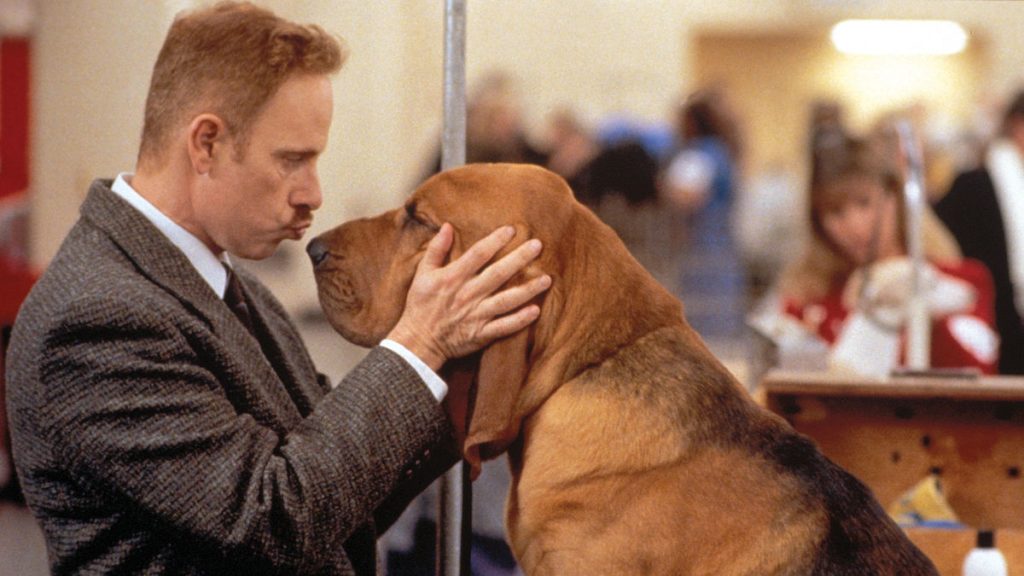In her memorable New Yorker review of 1971’s Dirty Harry (which turns 50 years old this month), critic Pauline Kale wrote “the action genre has always had a fascist potential, and it has finally surfaced.” She was hardly the only person to feel this way; other critics called out the film for its open animus towards civil liberties and embrace of violent policing methods (Roger Ebert also dropped the F-word in his review).
It’s hard to argue against Kael’s accusations, even if other parts of her review are patently ridiculous (her sarcastic assertion that “the greatest artists would be those who gave us heart attacks” reads as an accidental truth bomb). Dirty Harry indeed bears a fascist streak a mile wide, and it is clearly working as a right-wing power fantasy.
On the surface, the same would seem true of the four sequels that came about over the next 17 years, all of which hit the same expected beats set out by the first one: Harry Callahan (Clint Eastwood), a gruff, trigger-happy detective with the San Francisco Police Department, investigates a series of high profile murders, butting heads with his wishy-washy superiors and the liberal bureaucracy of his city’s government, before ultimately taking matters into his own hands and blowing away the bad guy in the end. Along the way, he will stumble upon one or several unrelated violent crimes—usually some sort of armed robbery committed by black or brown criminals—which he intercedes and stops by using excessive force, causing massive property damage and a PR headache in the process. He will also invariably find himself tagged with a new partner, usually an inexperienced member of a minority group, who will inevitably get killed or maimed in the line of duty. About the only things that change from one film to the next are the rising body count and number of cracks that line Eastwood’s grizzled mug.
However, watching each film in the series back-to-back-to-back (as I did recently), it’s not merely the tropes and repetitive structure that one notices. Throughout these five films, a strong sense of political anxiety consistently rises to the fore, anxieties that betray a deeper ambivalence about their core ideology and thus reveal them as more than simple right-wing power trips.
The original Dirty Harry was part of a wave of ‘70s movies about renegade cops working outside the confines of the law in order to get the job done. That these films came about shortly after the institution of new protections for individuals, such as Miranda rights, is no coincidence. As a whole, they can be seen as a backlash to the expansion of social liberties that conservatives, for all their talk of constitutional rights and individualism, claimed only helped criminals, but they also represent a wider recognition of the brutality, corruption and fascist leanings that have always been inherent to American policing.
More than any of these other examples, including the extremely similar The French Connection from the same year, Dirty Harry wore its reactionary politics proudly on its sleeve. Indeed, the film, which pits Eastwood’s proud, equal opportunity bigot (“Harry hates everybody: limeys, micks, Hebes, fat daggos, niggers, honkeys, chinks—you name it”) against a mad sniper called Scorpio, is one of the most reactionary American thrillers ever made, in that it was literally conceived in response to the real-life Zodiac murders that terrorized San Francisco only a few years prior. Of course, the real killer managed to elude justice, but Dirty Harry gave audiences a brief catharsis by having his fictional counterpart brought to justice (i.e.: gunned down) by a stalwart lawman, no thanks to the bureaucrats and bleeding hearts that stand in his way.
(Even though no one knew the identity, let alone the politics, of the real Zodiac killer—and as anyone who’s even briefly familiar with the case can tell you, one of the prime suspects was a blue-collar good ol’ boy—Dirty Harry nonetheless casts him as a flower child gone bad, which makes it as much a response to the Manson Family murders of three years prior [elements of infamous kidnapper Gary Stephen Krist were also incorporated]).
Dirty Harry is in keeping with several other great works from its director Don Siegel (such as Invasion of the Body Snatchers, The Killers, The Beguiled, Escape from Alcatraz, and Charley Varrick), in that its focus is on the on the mortal struggle of an individual against an antagonistic system that would do him in. The individual is by no means always the victor in these films, but he is in Dirty Harry, which makes it more of a libertarian, rather than authoritarian, fantasy—even if, in this case, said individual betrays many personal authoritarian qualities.
Still, it does a disservice to both Seigel and Eastwood’s work to act as though they present the character of Harry in a totally uncritical light. To do so, one has to willfully ignore how often Seigel shoots Eastwood to look like a raving lunatic and hulking ogre. This takes some work, for while today Eastwood’s grim and weathered visage is synonymous with the ideal of conservative masculinity, in 1971 he still cut a suave, even hip figure. He wouldn’t have been anyone’s first choice to embody Silent Majority rage, and indeed, the role of Harry Callahan was initially offered to more notably outspoken conservatives John Wayne and Frank Sinatra (liberals Burt Lancaster and Paul Newman were also approached to star, but they both turned it down because they disagreed with the script’s politics, although it was Newman who recommended Eastwood for the part).
The film ends in a similar manner to the leftist western classic High Noon, with Harry, utterly disillusioned with the institution of law enforcement, tossing aside his badge in disgust. A morally complex ending for a morally complex—if still clearly conservative—film.
But this did not wash with liberal critics, or, for that matter, most audience members, the majority of whom were happy to cheer for Harry with no compunction, or else condemn him for standing against their personal values. Today, such divisive animus would likely be embraced by the film’s makers in order to play directly to a conservative audience, but at the time, the criticism—and particularly Kael’s remarks—got to Eastwood. Over the years, he’d write and speak openly about how much umbrage he took with her review, at one point defending himself (and Seigel) in an open letter in the Village Voice, in which he wrote:
“Try a change of pace and do a film about concern for the victim instead of the accused and POW!, Kael screams ‘fascism,’ somebody else screams ‘Hitler,’ and several other publications have Don Siegel and myself to the right of Atilla the Hun.”

More interesting than Eastwood’s personal arguments is how his gripes informed the sequel to Dirty Harry. Released just two years later, Magnum Force saw Seigel step away from the director’s chair and replaced by Ted Frost, while uber-conservative New Hollywood maverick John Milius (who worked on a draft of the original Dirty Harry script) and future New Hollywood maverick-turned-sacrificial lamb Michael Cimino took on scripting duties at separate points.
The film goes out of its way to show how not fascist Harry is by pitting him against actual fascist cops. Picking up shortly after the events of the first film—Harry’s still a cop, his retirement at the end of the first movie never addressed—the bad guys this time are a squad of motorcycle deputies who carry out extrajudicial assassinations against members of San Francisco’s criminal underworld. They are a homegrown death squad modeled after those active in South American dirty wars of the time (who, it should be noted, often had the moral, fiduciary, and even military backing of the American government). Harry, who throughout the first movie angrily butted up against the systemic protections afforded to suspected criminals, now finds himself having to defend that same system.
The idea of rogue cops even more extreme than Dirty Harry originally came from none other than Terrence Malik, who, like Milius, worked on an early draft of the first film’s script. Still, as it plays out over the course of Magnum Force, it feels entirely of a piece with Milius’s larger body of work, which continually shows off a more complex shading of, and ironic sense of humor about, his outré politics (he’s often described himself as a “Zen anarchist”) than his detractors care to acknowledge.
Politics aside, Milius would end up disavowing the film, claiming he had nothing to do with the over-the-top climax or the awkward scenes of Harry hooking up with his sexy Chinese-American neighbor, which were included at the behest of Eastwood, who’d received lots of fan letters from women demanding a glimpse into the character’s love life (the mixed-race coupling was no doubt also intended to further defend the character from charges of racism).
And yet, lest one assume that the filmmakers had some grand political epiphany in the face of the first film’s reception, the movie muddles its message—which none of the critics, least of all Kael, bought anyway—by becoming a kind-of reverse Manchurian Candidate when it reveals the archvillain of the central plot to be Hal Holbrook’s left-leaning bureaucrat, who prior to the twist has spent the entire film castigating Harry for using excessive force and espousing the virtues of due process. It’s an insidious message, in that it holds that even when rightwing fascists perpetrate violent atrocities, it’s the liberal who’s at fault.
If the first Dirty Harry was a response to the turbulence of the radical cultural changes of ‘60s, Magnum Force can be read as reckoning with the failed promise of the Nixon era in the wake of the Watergate scandal. But America is nothing if not fickle, so by the time the next entry in the franchise came out, the political tide had turned once again.
Made during the Carter administration—a period defined by a sense of “malaise”—1976’s The Enforcer is back to blaming society’s evils on those damn hippies. Here, the villains are band of underground radicals modeled after the Symbionese Liberation Army, who wage a series of terrorist attacks in the leadup to kidnapping San Francisco’s weak, ineffectual mayor (they hold him for ransom on Alcatraz island). Unlike the first film, which merely dresses its villain like a hippy, but never makes any outright proclamations about the larger cultural clash, The Enforcer comes right out and says what’s on its mind, having the newly widowed wife of Harry’s slain partner (series regular, Fatso) declare, “It’s a war.”
The Enforcer also presents Harry at his most outspokenly retrograde, having him voice his opposition to the police department’s new affirmative action hiring policy, gleefully needle a group of black nationalists (“Mighty white of you,” he tells them at one point), viscously berate a leftist priest who sides with leftist revolutionaries, and get in some last minute homophobia by calling the gay-coded main antagonist a “fucking fruit” right before he blows him up with a rocket launcher. This last point is especially interesting when you consider a memorable line from the previous entry, in which Harry tells another cop who suggests that the cadre of villains might be gay, “If the rest of you could shoot like them, I wouldn’t care if the whole damn department was queer.”
The regression of the character is not entirely an expression of larger cultural backlash though. On at least a couple of levels, it’s key to his character development throughout the film. The Enforcer has Harry teaming up, against his will and much to his dismay, with a rookie female partner (Tyne Daly). The movie is pretty remorseless in showing how utterly naive and dangerously green she is—at one point, Harry saves her life by pulling her out of the way of a rocket launcher’s deadly backfire during a weapons demonstration—and of course, it can’t help but turn her into a romantic conquest. But over the course of the story, Harry (and by extension the audience) come to recognize her as a capable officer, at least up until she is killed during the final set piece. While her death is presented as a brave and noble sacrifice, it still proves Harry right in his initial pessimism over a woman’s ability to survive on the job. Still, the film is at least attempting to find some common ground with the second wave feminism of its day, even if it goes about it in a very lunkheaded fashion.
The same is true of the film’s depiction of the dwindling civil rights movement of the time: the Black Panthers-like organization that features in the plot has an antagonistic relationship with Harry, but ultimately, the two work together to bring down the white radicals. More interestingly, Harry sticks up for them when the rest of the police department, as well as City Hall, tries to pin the real villains’ crimes on them. This thread, which recognizes how the system, even when it puts on a liberal façade, is happy to scapegoat black political organizations, is the most ‘woke’ the franchise ever got.

The series’ next entry, Sudden Impact (1983)—the sole Dirty Harry film to be directed by Eastwood and, as such, by far the best made after the original—serves as an even bigger course correction to Magnum Force, while also continuing to explore the gender dynamics introduced in The Enforcer.
The only one of these films in which the majority of the action takes place outside of San Francisco, Harry finds himself searching for the person responsible for a series of gruesome male slayings (each victim has his balls blown off). That person turns out to be a beautiful artist name Jennifer Spencer (Sondra Locke, Eastwood’s real-life wife at the time), who is avenging the brutal gang rape of herself and her sister years earlier. Harry’s investigations lead him to the small coastal community in Northern California where the original assault first occurred, and where he strikes up a romance with Spencer before realizing she’s the culprit he’s after.
Sudden Impact is as much a rape-revenge movie focusing on Spenser as it is a police procedural revolving around Harry, and as such, it feels the least attached to the other films. Like most other rape-revenge movies of its era, it uses graphic depictions of sexual violence to make a point about misogynist violence, even as it exploits those same depictions for prurient thrills. It at least presents its female avenger as justified in her actions, with Harry ultimately opting to let her walk—in so doing, contradicting the anti-vigilantism stance of Magnum Force—although the film can’t help but cover its ‘both sides’ bases by making the most grotesque and hateful of its villains a butch lesbian.
(Sudden Impact’s biggest cultural influence came about by way of the famous line “Make my day,” which would go on to be quoted by movie tough guy President Ronald Reagan, although it should be noted that the line was cribbed from the far superior Vice Squad from the year prior.)
As successful as all of the Dirty Harry movies were, the well was running dry by the time 1988’s The Dead Pool came along. Directed by former stunt coordinator Buddy Van Horn, it is by far the silliest and most cartoonish of the bunch, although it’s also the most purely entertaining after the first one.
On the face of things, The Dead Pool is also the least political of the series. The film—which sees Harry investigating the killing of several cast and crew members shooting a horror film in San Francisco (said cast and crew include Liam Neeson as the pony-tailed director Swan and a young Jim Carrey as a drug-addicted movie star)—plays like a giallo in which Harry confusingly stumbles into, and thus, there’s not a lot of opportunities for political statements.
However, this is where the franchise goes meta, the film-within-a-film serving as a backdrop for Eastwood and company to settle some scores—foremost amongst them with Kael, who is given a very obvious on-screen counterpart that gets eviscerated by the killer. Cheap a ploy as this is, it unintentionally reveals some deep-seated self-loathing on the part of the filmmakers. The movie-obsessed killer (a failed screenwriter—read into that what you will—and a product of a revolving-door carceral state, natch), makes the Kael doppelganger admit to liking the vapid horror movies he’s obsessed with, which she is more than willing to do to save herself (and which, in turn, ensures her doom).
This is meant to show how spineless she is, but here’s the thing: if the character is meant as a stand-in for Kael, then the films she regards as trash—rightly, as The Dead Pool makes clear—are, by necessity, stand-ins for Dirty Harry and its sequels. There’s a lot of talk throughout The Dead Pool about the artistic merit and moral responsibility of movies, and it’s obvious from the disdainful way that Harry regards Swan and his work that we are meant to share his antipathy. And yet, the descriptions of the movies as shallow gore-fests can be applied directly to The Dead Pool, since their murder set-pieces are the same used to inspire the murder set-pieces we are actually watching.
The anxieties about its own merit at the heart of The Dead Pool are representative of the larger anxieties prevalent throughout the entire series. Over five movies and two decades, they consistently contradict themselves and their purported worldview, while unintentionally exposing a deep streak of self-doubt and even shame.
Ultimately, they still (mostly) succeed as entertaining action movies, with the first one remaining a stone cold classic. But in their attempt to cover up their anxieties with so much macho posturing and reactionary anger, they end up being far more representative of the right-wing mindset than even they seem to realize.
To paraphrase Harry’s catchphrase from Magnum Force, sometimes a movie’s got to know its limitations.



